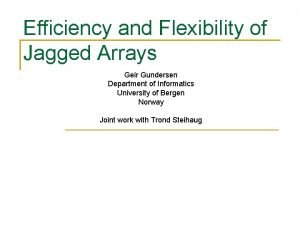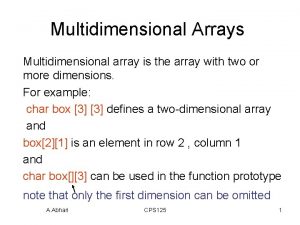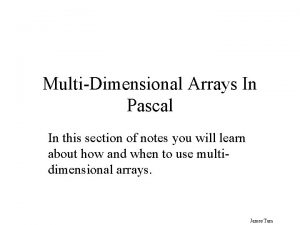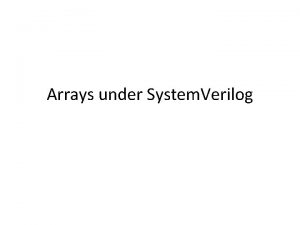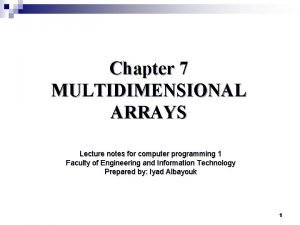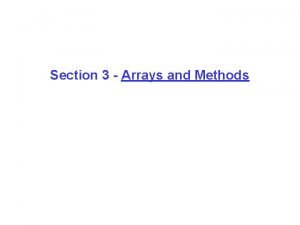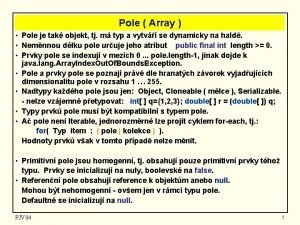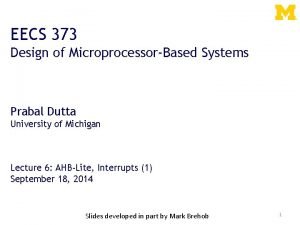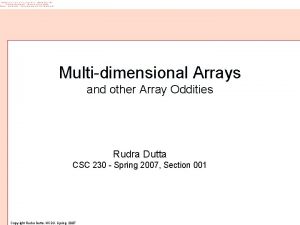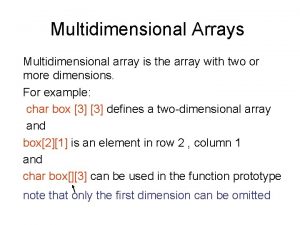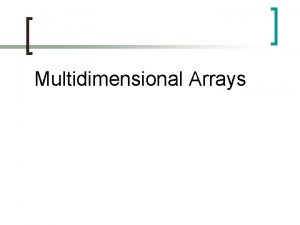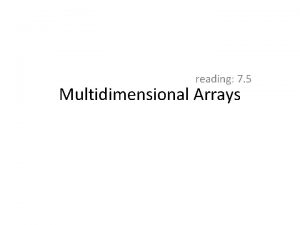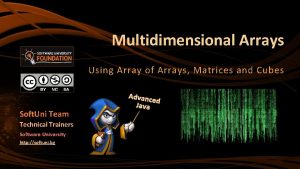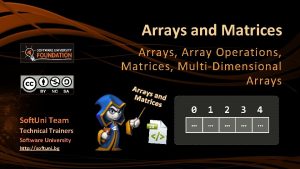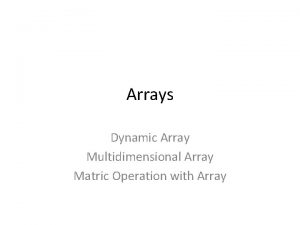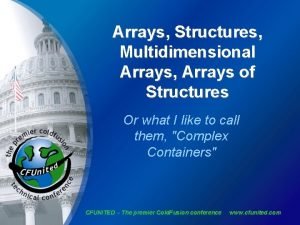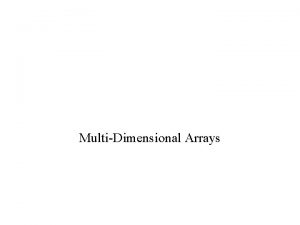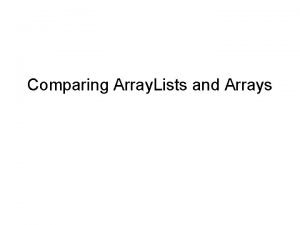Multidimensional Arrays and other Array Oddities Rudra Dutta



![Arrays and sizeof int id [1000]; int *pointer. Id; l l l sizeof(id) is Arrays and sizeof int id [1000]; int *pointer. Id; l l l sizeof(id) is](https://slidetodoc.com/presentation_image_h2/cc2cdc4f556b9256b0f19cd9759accc5/image-4.jpg)
![Passing Arrays id[1] = 20; pid[20] = 1; vid[0] = 6; tid[6] = 21; Passing Arrays id[1] = 20; pid[20] = 1; vid[0] = 6; tid[6] = 21;](https://slidetodoc.com/presentation_image_h2/cc2cdc4f556b9256b0f19cd9759accc5/image-5.jpg)
![2 -dimensional Arrays int values[2][3]; l Recall that values[] looks just like a pointer 2 -dimensional Arrays int values[2][3]; l Recall that values[] looks just like a pointer](https://slidetodoc.com/presentation_image_h2/cc2cdc4f556b9256b0f19cd9759accc5/image-6.jpg)







- Slides: 13

Multi-dimensional Arrays and other Array Oddities Rudra Dutta CSC 230 - Spring 2007, Section 001 Copyright Rudra Dutta, NCSU, Spring, 2007

Array Syntax l Recall – l Arrays are alternative representations of blocks of memory pointed to by pointers To define an array: – type array. Name[size]; Size should be static (compiler can compute) l For example l int id[1000]; – char *names[2*50+1]; – #define SIZE 10 – double scores[SIZE+1]; – l id is like int * names is like char** Variable size is okay on the stack Not in global variables – (C 99 prohibits variable even on stack) – Copyright Rudra Dutta, NCSU, Spring, 2007 2

Passing Arrays, Again l When passing as argument, it is purely a pointer Size must be passed some other way – Additional parameter is obvious way – void func 1 (double val[], int num_elements); – void func 1 (double *val, int num_elements); – – void func 3 (double val[20]); ? ? ? Copyright Rudra Dutta, NCSU, Spring, 2007 3
![Arrays and sizeof int id 1000 int pointer Id l l l sizeofid is Arrays and sizeof int id [1000]; int *pointer. Id; l l l sizeof(id) is](https://slidetodoc.com/presentation_image_h2/cc2cdc4f556b9256b0f19cd9759accc5/image-4.jpg)
Arrays and sizeof int id [1000]; int *pointer. Id; l l l sizeof(id) is 1000*sizeof(int) – NOT 1000 l sizeof(pointer. Id) is the number of bytes used to store a pointer to an int. l The following sets pointer. Id to the last element of the array id: pointer. Id = id + sizeof(id)/sizeof(id[0]) - 1; Copyright Rudra Dutta, NCSU, Spring, 2007 4
![Passing Arrays id1 20 pid20 1 vid0 6 tid6 21 Passing Arrays id[1] = 20; pid[20] = 1; vid[0] = 6; tid[6] = 21;](https://slidetodoc.com/presentation_image_h2/cc2cdc4f556b9256b0f19cd9759accc5/image-5.jpg)
Passing Arrays id[1] = 20; pid[20] = 1; vid[0] = 6; tid[6] = 21; #include <stdio. h> #include <stdlib. h> printf ("%d %dn", sizeof(id), sizeof(pid), sizeof(vid), k, sizeof(tid), sizeof(iid)); typedef int mintar[1000]; void test (int fid[20]) { printf ("%d n", sizeof(fid)); } test(id); } int main () { int id[1000]; int * const pid = malloc (1000 * sizeof(int)); int k = rand(); int vid[k]; mintar tid; int iid[] = {1, 2, 3}; Copyright Rudra Dutta, NCSU, Spring, 2007 5
![2 dimensional Arrays int values23 l Recall that values looks just like a pointer 2 -dimensional Arrays int values[2][3]; l Recall that values[] looks just like a pointer](https://slidetodoc.com/presentation_image_h2/cc2cdc4f556b9256b0f19cd9759accc5/image-6.jpg)
2 -dimensional Arrays int values[2][3]; l Recall that values[] looks just like a pointer access l int a [3] l – l “a is a pointer to a block of 3 ints” int values [2] [3]; – “values is an array of 2 pointers to block of 3 ints” – “Pointer to block of 2 pointers to block of 3 ints” But internally “flattened” l Can be accessed as pointers l Copyright Rudra Dutta, NCSU, Spring, 2007 6

Blocks Containing Pointers l Can create the structure explicitly with pointers block points to a block containing three pointers to double – In order to access a single object, the code has to apply dereferencing twice to block – l For a block b of pointers, b[i][j] refers to the j-th object in a block pointed to by b[i] Copyright Rudra Dutta, NCSU, Spring, 2007 7

Blocks Containing Pointers double **block; #define SIZE 3 if((block=calloc(SIZE, sizeof(double*)))==NULL) { /* error code */ } for(i = 0; i < SIZE; i++) if((block[i]=calloc(1, sizeof(double)))==NULL) { /* error code */ } *(*block) = 2. 1; block[0][0] = 2. 1; Copyright Rudra Dutta, NCSU, Spring, 2007 /* initialize block */ for(i = 0; i < SIZE; i++) block[i][0] = 2. 1 + i; /* free memory */ for(i = 0; i < SIZE; i++) free(block[i]); free(block); block = NULL; 8

Pointers vs. Multi-Dim Arrays l Array notation may be simpler (initially) – Is less efficient l – Wastes space for strings l l Internally, compiler re-creates pointer structure Internally, space must be reserved for longest sub-array Pointer notation is complicated, but consistent But incurs explicitly space for extra pointers – However, only space required is actually used – l In general, memory management becomes programmer’s task beyond simple cases Copyright Rudra Dutta, NCSU, Spring, 2007 9

Another Way: Explicit “Flattening” Ultimately, multi-dimensional arrays must be kept in (1 dimensional) memory l This “flattening” can be explicitly handled by the programmer to avoid the overhead of pointer arrays l Disadvantage: cannot access with multi-d array notation any more l int *p; p = (int *) malloc (cols * rows * sizeof (int); *(p + cols *i + j) = 5; /* element of Row i, Column j */ Copyright Rudra Dutta, NCSU, Spring, 2007 10

Main Function’s Arguments hex file 1 file 2 int main(int argc, char **argv); int main(int argc, char *argv[]); Copyright Rudra Dutta, NCSU, Spring, 2007 11

Command Line Arguments l Many (most? ) programs have command line options or arguments – l E. g. , man, gcc, … These are passed to the program as input parameters of the function main() First parameter: count of the number of arguments – Second parameter: an array of pointers to the arguments (which are character strings) – l By convention, the first argument is defined to be the name by which this program was invoked Copyright Rudra Dutta, NCSU, Spring, 2007 12

Command Line Arguments l The following just prints out the command line arguments, one by one (starting with program name) Count of # of arguments Array of pointers to arguments #include <stdio. h> int main(int argc, char **argv) { int i; for (i=0; i < argc; i++) printf("%sn", *argv++); return 0; } Copyright Rudra Dutta, NCSU, Spring, 2007 13
 Jagged array
Jagged array Array of arrays c++
Array of arrays c++ Multidimensional array
Multidimensional array Arrays in pascal
Arrays in pascal Systemverilog multidimensional array initialization
Systemverilog multidimensional array initialization Processing multidimensional array
Processing multidimensional array Array 1 dimensi dan 2 dimensi
Array 1 dimensi dan 2 dimensi C# multidimensional array initialization
C# multidimensional array initialization Java copy array
Java copy array Niloy dutta uconn
Niloy dutta uconn Chris keane wsu
Chris keane wsu Anup dutta hcl
Anup dutta hcl Prabal dutta
Prabal dutta Dipanwita dutta
Dipanwita dutta
